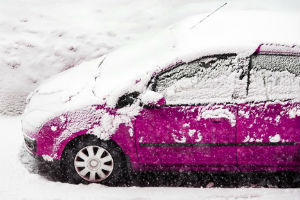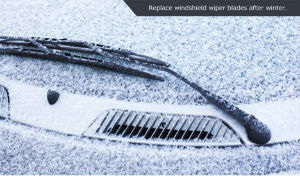Winter weather is hard on all of us, and that includes our cars. In fact, not only can snow and ice make driving a challenge, but the ice used to melt slippery roads can also harm your car. So when winter weather begins to wane, it’s time to take a look at what’s going on with your vehicle and consult a professional when auto repair becomes necessary.
Here are some warning signs that winter has done damage to your car:
Hit The Ice

When caked on your car, it may be tempting to use a shovel or large ice scraper to push the big sheets off. While ice scrapers are obviously designed to remove ice, it’s important to remember that they’re only meant for your windows. Using an ice scraper on your car’s paint can leave scratches and damage the finish. And of course, avoid shovels at all costs – that’s not what they’re meant for.
A better idea for removing ice is to lift the largest chunks off with your hands or simply heat up your car, allowing it to slowly melt away. You don’t want to push ice chunks off because they’ll leave small scrapes along the surface of your car. And don’t try pouring hot water on your windows – the sudden temperature change can cause them to shatter and the water will freeze in your driveway. If you try this, you won’t be going anywhere, but you will be paying a big auto repair bill to replace your windows.
Wipe Winter Away
People rarely replace their windshield wiper blades as often as they should, so take advantage of the end of winter and replace yours now. Your windshield wipers have worked hard this winter pushing heavy snow and ice off your windows and keeping them clear during storms. They’ve also likely dealt with some scattered ice, and all of this will have left them rather weathered.
The usual rule for windshield wiper replacement is six months, but even if you put new ones on right before the holidays, we recommend replacing them when winter ends. Six months looks a lot different when it’s full of gentle spring rain than when snow storms are in full effect.
Struggling With Salt

When you give your car its post-winter inspection, watch out for rust spots caused by salt. On the exterior of your car, this isn’t a big deal – it doesn’t look very nice, but if it isn’t on a functional aspect, you can take your time getting that refinished. However, you’ll need to take a closer look underneath the car. Sub-frame damage can become a permanent problem and impact your resale value due to its integral role in the overall car structure.
Salt corrosion may also cause your car to develop hydraulic brake leaks. You may not be able to tell that this is an issue, but if you see salt damage in the surrounding area, check with a professional. Any brake repairs need to be done in the shop anyway, so don’t delay getting this issue proper attention.
You can stave off winter salt problems by keeping your car clean throughout the winter months, but this can be labor intensive. Any time you try to clean off your car, rinse down the whole thing first and attempt to remove as much ice as possible without rubbing it into the surface of the car. Never use professional car washes unless they advertise touchless service. During the winter, these car washes may actually add more salt and grime to your car than they remove.
When Good Salt Goes Bad
As noted, normal road salt only works within about 20 degrees of water’s typical freezing point, and beyond that it ceases to be especially useful for improving road navigability. But even though adding calcium chloride or another chloride to the combination can push the freezing point even lower, car specialists are skeptical about the process, saying the damage it causes to cars outweighs its benefits.
What can the salt and chloride combinations do? Since the goal of this combination is an exothermic chemical reaction, the associated rusting becomes much more severe. Most states now use this combination if they have significant winter weather, but mechanics suggest that a switch back to the old sand and salt mixture could benefit the cars that come into the shop. Using “salt priority” – the combination of salt and chloride – can send car brake pedals right through the floor of the vehicle due to severe rusting. This is all the more reason for car owners to turn to professionals for post-winter inspections.
Winter Damage Wonder Workers
As winter weather comes to a close, it’s time to get your car looked at to ensure you can ride safely into spring. Contact RC Auto Specialists today to make an appointment with our car care professionals. They can help clear up any rust spots, check for corrosion damage, replace your windshield wipers, and make sure all your parts are in working order.
Due to the increasingly severe damage caused by salt and “salt priority,” cars are looking rather worse for wear after a season of snow and ice. Treat your car as well as you treat yourself – make RC Auto Specialists your go-to auto repair company. We’ll treat your car like our own.
